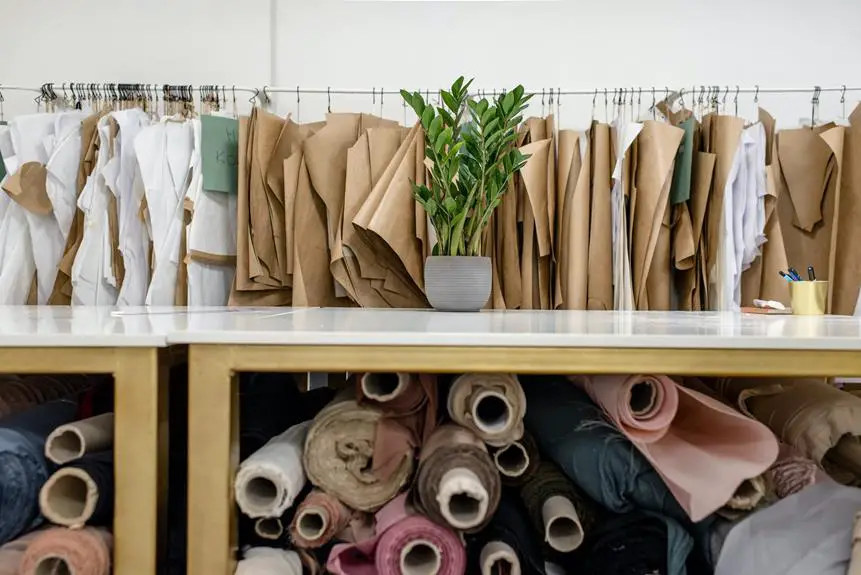So, you've heard about luxury cotton fabrics, but have you ever wondered if there's one that stands out as the most expensive in the world?
Well, get ready to delve into the realm of high-end textiles as we explore the possibility of the world's most expensive cotton fabric.
From its prestigious history to the meticulous production process, rare varieties, and the influence of top designers, there's a lot that contributes to its astonishing price tag.
This fabric isn't just about luxury; it's about exclusivity, craftsmanship, and a heritage that commands attention.
If you're ready to uncover the details behind this textile marvel, then hold on to your seat as we unravel the world of opulent cotton fabrics.
Key Takeaways
- Luxury cotton has a prestigious history that spans centuries and is deeply rooted in artisanal production and craftsmanship.
- The production process of luxury cotton involves traditional handcrafted techniques and meticulous attention to detail.
- Rare and exclusive cotton varieties, such as Sea Island Cotton, Giza Cotton, and Supima Cotton, are highly sought after for their unique characteristics.
- The influence of high-end designers can shape consumer preferences and market trends, impacting the dynamics of the luxury cotton fabric industry.
The Origin of Luxury Cotton
You can trace the origin of luxury cotton to the ancient civilizations of the Indus Valley, where the cultivation of this prized fiber first began. The historical significance of luxury cotton is deeply rooted in the artisanal production and premium quality that has been associated with it for centuries. The Indus Valley civilization, known for its advanced urban planning and trade, played a pivotal role in the development of luxury cotton. The premium quality of the cotton produced in this region was highly sought after, leading to its extensive trade with other ancient civilizations.
The craftsmanship and attention to detail in the artisanal production of luxury cotton have been revered throughout history. The meticulous methods employed in cultivating and processing this cotton contributed to its reputation for unparalleled quality and desirability. It's this dedication to excellence that has elevated luxury cotton to its esteemed status in the world of textiles.
Understanding the historical roots of luxury cotton provides a profound appreciation for the legacy of premium quality and exquisite craftsmanship that continues to define it today.
The Meticulous Production Process
Now, let's talk about the intricate production process behind this luxurious cotton fabric.
You'll be fascinated to learn about the traditionally handcrafted techniques and the artisanal attention to detail that goes into creating this exquisite material.
It's a process that truly embodies the artistry and dedication of skilled craftsmen.
Traditionally Handcrafted Techniques
The production process for this exquisite cotton fabric involves traditional handcrafted techniques that require great skill and precision. These handcrafted traditions have been meticulously passed down through generations, ensuring that each piece is crafted with the utmost care and attention to detail.
Here's what goes into creating this unparalleled fabric:
- Spinning: Artisanal expertise is showcased in the delicate and precise spinning of the cotton fibers, ensuring a fine and consistent yarn.
- Weaving: The intricate weaving process, performed by skilled artisans, results in the creation of the fabric's unique and luxurious texture.
- Dyeing and Finishing: The fabric undergoes meticulous dyeing and finishing processes, where traditional techniques are employed to achieve its rich and vibrant colors, as well as its exceptional softness and luster.
This level of craftsmanship truly sets this cotton fabric apart, making it a masterpiece of traditional handcrafted techniques.
Artisanal Attention to Detail
Continuing from the meticulous handcrafted techniques involved in the production process, the artisanal attention to detail in creating this cotton fabric sets a standard of excellence that's unparalleled in the industry. Every step of the way, from selecting the finest cotton fibers to weaving and finishing, the process is infused with artisanal craftsmanship.
The intricate detailing in the fabric is a testament to the dedication and skill of the artisans involved. Each thread is carefully inspected and adjusted to ensure uniformity and strength, resulting in a fabric of exceptional quality. The meticulous attention to detail not only enhances the fabric's aesthetic appeal but also contributes to its durability and luxurious feel.
This level of precision and care in production truly sets this cotton fabric apart as a masterpiece of artisanal craftsmanship.
Rare and Exclusive Cotton Varieties
You'll find several rare and exclusive cotton varieties that are highly sought after by discerning textile enthusiasts. These exclusive textiles are prized for their exceptional quality, unique characteristics, and limited availability.
Here are three rare and exclusive cotton varieties that are revered by textile connoisseurs:
- Sea Island Cotton: Grown in the Caribbean, Sea Island Cotton is celebrated for its exceptionally long staple fibers, which contribute to its luxurious feel and remarkable strength. This rare fabric is renowned for its silky texture and natural sheen, making it highly coveted for crafting exquisite shirts and high-end textiles.
- Giza Cotton: Hailing from the Nile River Valley in Egypt, Giza Cotton is revered for its exceptional fineness, softness, and durability. This rare and exclusive cotton variety is favored for its ability to produce fabrics with a lustrous appearance and a smooth, luxurious feel, making it a top choice for creating premium bed linens and fine clothing.
- Supima Cotton: Known for its superior strength, softness, and color retention, Supima Cotton is a rare and exclusive variety grown exclusively in the United States. Its extra-long staple fibers result in fabrics that are exceptionally smooth, durable, and resistant to pilling, making it a sought-after choice for creating high-quality, long-lasting garments and linens.
Handcrafted Artistry and Detailing
When considering handcrafted artistry and detailing in cotton fabrics, it's essential to appreciate the meticulous care and skill that goes into creating intricate designs and embellishments. Artisanal craftsmanship plays a pivotal role in elevating cotton fabric to the realm of luxury fashion trends. The intricate detailing found in high-end cotton fabrics often involves a blend of traditional techniques and innovative approaches, showcasing the expertise of skilled artisans.
Artisanal craftsmanship infuses each fabric with a unique character, making it a testament to the dedication and precision of the artisans involved. Whether it's delicate hand embroidery, exquisite lacework, or intricate hand-drawn designs, the level of detail and artistry in these fabrics is unparalleled.
In luxury fashion trends, discerning consumers are drawn to the exclusivity and individuality offered by handcrafted cotton fabrics. The meticulous detailing not only adds a touch of opulence but also reflects a deep appreciation for the art of textile craftsmanship. Each piece tells a story of exquisite skill and attention to detail, making handcrafted cotton fabrics a coveted choice for those who seek mastery in their textile selections.
The Influence of High-End Designers
The influence of high-end designers on the luxury cotton fabric industry is undeniable. When influential designers embrace a particular fabric, it can significantly impact the luxury market dynamics.
Here's why their influence matters:
- Trendsetting Creations: High-end designers have the power to set trends in the fashion industry. When they incorporate a specific cotton fabric into their creations, it can lead to a surge in demand for that fabric, elevating its status within the luxury market.
- Prestige and Exclusivity: High-end designers often work with the finest materials to maintain their brand's image of prestige and exclusivity. By choosing a particular cotton fabric for their designs, they can enhance the fabric's perceived value and desirability, creating a ripple effect throughout the industry.
- Shaping Consumer Preferences: The choices made by influential designers can shape consumer preferences and perceptions. When a renowned designer showcases a cotton fabric in their collection, it can influence consumers to seek out that fabric, driving up its demand and market value.
In essence, the involvement of influential designers in championing specific cotton fabrics can substantially impact the luxury market, shaping trends and driving demand.
Prestigious History and Heritage
You're about to discover the rich textile legacy and exquisite craftsmanship tradition behind what may be the world's most expensive cotton fabric.
This fabric has a prestigious history and heritage, rooted in centuries of expertise and artistry. As we explore its origins and the meticulous techniques used in its production, you'll gain a deeper appreciation for the unparalleled quality and value it represents.
Rich Textile Legacy
With a prestigious history dating back centuries, you've inherited a rich textile legacy that continues to inspire the world. Your rich heritage in crafting luxurious fabric has left an indelible mark on the global textile industry. Here's why your textile legacy stands out:
- Timeless Elegance: Your rich textile legacy is marked by timeless elegance, with designs and techniques passed down through generations, preserving the essence of luxury and sophistication.
- Innovative Techniques: Embracing tradition while also pushing the boundaries of innovation, your legacy has continuously introduced groundbreaking techniques that have set new standards in the textile world.
- Global Influence: Your rich textile legacy has transcended borders, captivating the imagination of connoisseurs worldwide and leaving an enduring impact on the global fashion and design landscape.
Your rich textile legacy is a testament to the mastery and artistry that has been upheld for generations, shaping the very fabric of luxury.
Exquisite Craftsmanship Tradition
Embedded in your prestigious history and heritage is a tradition of exquisite craftsmanship that has set the standard for luxury textiles around the world. The craftsmanship skills and weaving techniques passed down through generations have contributed to the unparalleled quality of the cotton fabric.
Artisans meticulously weave each thread with precision, creating intricate patterns and textures that showcase the mastery of their craft. The attention to detail and the pursuit of perfection are evident in every aspect of the fabric, from the initial stages of spinning the cotton fibers to the final touches of the weaving process.
This dedication to preserving traditional techniques while embracing innovation has solidified your reputation as a purveyor of exceptional textiles, admired by connoisseurs who appreciate the timeless artistry and expertise woven into every exquisite piece.
Sustainability and Ethical Sourcing
Considering the environmental and ethical implications of cotton production, sourcing sustainably and ethically is crucial for the industry. When it comes to sustainability and ethical sourcing in the cotton industry, there are a few key practices to keep in mind:
- Organic Cotton Farming: Opting for organic cotton farming methods reduces the use of harmful chemicals, promotes soil health, and minimizes environmental impact. Look for products made from organic cotton to support sustainable practices.
- Fair Trade Certification: Choosing products with Fair Trade certification ensures that the cotton was sourced ethically. This means that the farmers and workers involved in the production process were paid fair wages and operated in safe working conditions, promoting social sustainability.
- Transparency and Traceability: Seek brands that are transparent about their sourcing practices and supply chain. Companies that prioritize transparency and offer traceability of their cotton supply chain demonstrate a commitment to ethical sourcing and sustainable production.
The Astonishing Price Tags
When assessing the astonishing price tags associated with cotton fabrics, it's crucial to factor in the sustainability and ethical sourcing practices to understand the true value of the product. In the luxury market, price comparisons reveal that the world's most expensive cotton fabrics often come with a hefty price tag. These fabrics aren't just about their thread count or weave, but also about the ethical and sustainable practices employed in their production. The astonishing price tags attached to these fabrics are a reflection of the meticulous care taken at every step of the process, from the sourcing of raw materials to the weaving of the final fabric.
Luxury market trends show that the demand for these high-priced cotton fabrics is on the rise as consumers increasingly seek out products that align with their values of sustainability and ethical sourcing. The price tags associated with these fabrics may seem astonishing at first glance, but when you consider the craftsmanship, ethical practices, and the superior quality of the material, it becomes clear why they command such high prices in the market. Understanding the astonishing price tags of these cotton fabrics requires a holistic view that goes beyond mere cost and delves into the intricate details of their production and sourcing.
Frequently Asked Questions
What Are the Specific Countries or Regions Where Luxury Cotton Is Predominantly Grown and Harvested?
Exclusive markets in Egypt, Peru, and the US are known for luxury cotton. These regions prioritize sustainable practices, resulting in high-quality and costly cotton. It's fascinating to see how these specific areas excel in producing such sought-after fabric.
How Does the Production Process for Luxury Cotton Differ From That of Regular Cotton?
In the production process of luxury cotton, quality standards are paramount. The process involves meticulous harvesting, careful handling, and stringent quality control measures. This results in a fabric of exceptional softness, durability, and luster.
Are There Any Specific Environmental or Geographical Factors That Contribute to the Rarity of Exclusive Cotton Varieties?
Geographic factors, like climate and soil, impact the rarity of exclusive cotton varieties. Environmental impact is crucial; sustainable farming practices and limited water supply contribute to the scarcity, making luxury cotton highly sought after.
Can You Provide Details on the Specific Techniques and Skills Involved in the Handcrafted Artistry and Detailing of Luxury Cotton Fabric?
To create luxury cotton fabric, handcrafted artistry and detailing techniques are essential. Ethical sourcing and sustainability practices contribute to its exclusivity. Skilled artisans meticulously weave, dye, and finish the fabric, resulting in exquisite quality.
What Specific Ethical Sourcing Practices Are Implemented to Ensure the Sustainability of Luxury Cotton Production?
To ensure sustainability in luxury cotton production, ethical sourcing practices like fair trade and labor standards are implemented. These practices prioritize workers' welfare, environmental conservation, and fair compensation, contributing to the long-term sustainability of the industry.
- Can You Get Organza Wet? - April 23, 2024
- Why Is Organza so Popular? - April 23, 2024
- What Do You Wear With Organza? - April 23, 2024








